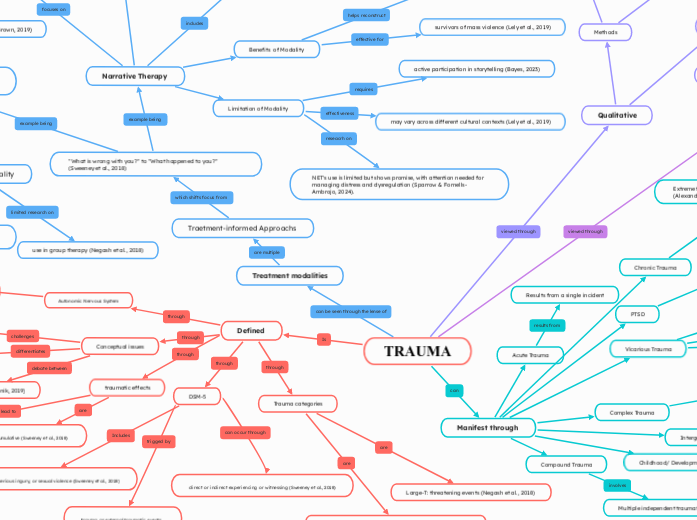da Doreen Waran mancano 8 mesi
80
TRAUMA
Trauma treatment approaches have evolved to focus on understanding patients' experiences rather than merely diagnosing symptoms. Eye Movement Desensitization and Reprocessing (EMDR)

da Doreen Waran mancano 8 mesi
80

Più simili a questo
Narrative Therapy
reshape emotional understanding and reconcile different aspects of oneself, facilitating a return to competency and empowerment (Bayes, 2023).
Narrative Exposure Therapy (NET) for PTSD (Lely et al., 2019; McPherson, 2011)
often used in diverse contexts, including with children and refugees (Peltonen & Kangaslampi, 2019; Wright et al., 2020).
significantly reduce PTSD symptoms compared to other treatments, waitlists, or treatment as usual (McPherson, 2011).
Focuses on how storytelling helps us make sense of our lives, with trauma often dramatically altering our narratives (Bayes, 2023).
may vary across different cultural contexts (Lely et al., 2019)
active participation in storytelling (Bayes, 2023)
NET's use is limited but shows promise, with attention needed for managing distress and dysregulation (Sparrow & Fornells-Ambrojo, 2024).
identity and self-concept (Bayes, 2023)
survivors of mass violence (Lely et al., 2019)
Eye Movement Desensitization and Reprocessing (EMDR)
with other therapies like Emotionally Focused Therapy (EFT) for treating trauma in couples (Negash et al., 2018; Gonzalez-Vazquez et al., 2018).
8-stage protocol (Shapiro & Brown, 2019)
PTSD, complex trauma (Shapiro & Brown, 2019)
Limitation of Modality
use in group therapy (Negash et al., 2018)
Extended stabilization phase for complex trauma (Gonzalez-Vazquez et al., 2018)
Benefits of Modality
verbal recounting of trauma (Shapiro & Brown, 2019)
single-event trauma (Shapiro & Brown, 2019)
Lehrner & Yehuda (2018) used Critical Interpretive Synthesis (CIS), an inductive qualitative process, to generate new theory from reviewed literature of Preventing intergenerational trauma transmission. The aim was to synthesize and critically interpret literature on intervening in the intergenerational transmission of relational trauma within parent-infant relationships.
Negash et al. (2018) used a qualitative case study to show the effectiveness of integrating EFT and EMDR in couples therapy.
Police Support Personnel (Huey et al., 2023) study used Semi-structured interviews to understand Vicarious trauma exposure and long-term effects